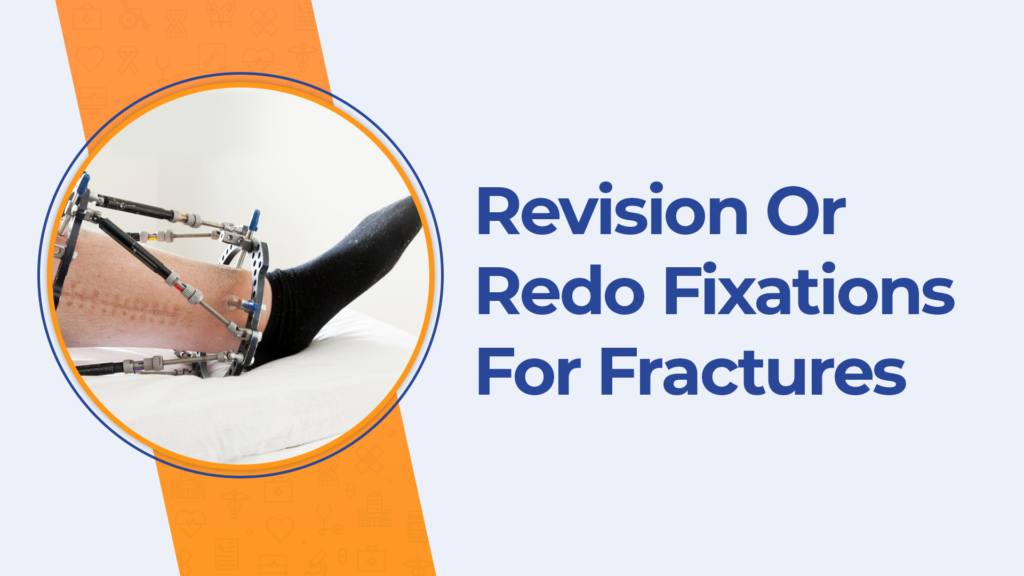Revision or redo fixations for fractures
Broken bones generally have the potential to heal without surmounting any complications in most cases wherein a new bone tissue develops and bridges the broken pieces of bone together.

Services
Methodology
Step 1:
Consultation
Book your appointment through Whatsapp or by dialing up @Mobile Number.
Step 2:
Investigation
The doctor inspects your issue extensively to completely understand the cause and the issues associated with your ailment.
Step 3:
Treatment Plan
A detailed treatment plan is created based on your unique needs and requirements.
Step 4:
Treatment
With each treatment that you undergo, you are advancing towards recovery.
Step 5:
Post-treatment follow up
Our team follows up to keep track of your recovery progress.

What is a Revision Or Redo Fixation For Fractures?
The main objective of fracture fixation is to stabilise the fractured bone, promote rapid bone healing, and to quickly restore full mobility and function of the injured extremity. Treatment options for fractures include conservative measures alongside external and internal fixation.
A closed reduction is used as a conservative bone fracture treatment to realign the bones. Then, stability is achieved through external splinting using slings, splints, casts, or through traction. In some cases braces are used to restrict a joint’s range of motion.
In most cases, new bone tissue grows and bridges the fragments of broken bone. Rarely, fractures fail to heal in spite of medical treatments and therapies. This is known as a “non union fracture,” which occurs when the bone fracture does not heal within the expected time frame. This is when a Revision for Fractures or Redo Fixation is needed.
What are the various ways to perform a Redo Fixation?
There are numerous ways to carry out fracture fixation, and there are undoubtedly numerous implant types to take into account. With new technological developments and a better understanding of how fractures heal, these implants are constantly being improved. In order to reduce the overall trauma to the injured area and significantly increase the protection of the local skin and muscles, surgical procedures are now becoming minimally invasive.
What is an Open Reduction Internal Fixation?
One commonly used term to describe surgical fracture stabilisation is Open Reduction Internal Fixation (ORIF). This implies that a formal incision is made (Open), the bones are realigned (Reduction), and an implant is used (Internal Fixation) to keep that alignment so that the body can heal the fracture naturally. Stainless steel and titanium are two common metals used to make these implants. Most of these are made to remain inside the body permanently; they are only removed if they are found in areas where they may later cause pain.
When is a Revision or Redo Fixation for Fractures recommended?
Revision or Redo Fixation is an orthopaedic procedure that entails the surgical placement of implants for the purpose of bone repair. Stainless steel, titanium alloy, cobalt-chrome alloy, or plastic are all acceptable materials for internal fixators.
Here are some of the typical causes for recommending a Revision or Redo Fixation:
- Experiencing continuous discomfort at the fracture site (even after 9 months to 1 year)
- Difficulty bearing weight
- Pressure on the affected limb
- Infection at the site of the fracture (pus or fluid discharge)
- X-rays that don’t show any bone-to-bone contact at the implant or fracture site.
Revision or Redo Fixation recovery time
Depending on the patient’s condition, the recovery process can last up to 3 months or longer.
FAQs
- Experiencing continuous pain at the fracture site ( Even after 9 months to 1 year)
- Difficulty bearing weight
- Pressure on the affected limb.
- Infection at the fracture site (Pus Or fluid discharge)
- X Rays that show no contact of bone at fracture site or Implant Failure.
How long does the service take?
The service depends upon the severity of the issue.
How long does the recovery take?
The recovery period usually takes up to 3 months or even more depending on the patient’s condition.
